Analyzing Conflict Management Strategies: Collaboration and Compromise
VerifiedAdded on 2023/03/17
|11
|2716
|59
Essay
AI Summary
This essay delves into the critical topic of conflict management within organizational settings. The central argument posits that compromise and collaboration are two highly effective strategies for mitigating conflict. The introduction sets the stage by highlighting the prevalence of conflict in group settings and the time managers spend addressing such issues. The discussion section explores various conflict management strategies, with a detailed analysis of collaboration and compromise. Collaboration is presented as a method that fosters communication, empathy, and mutual respect, while compromise is examined as a strategy for finding middle ground, especially in time-constrained situations. The essay also addresses the importance of cultural differences and communication styles. It further discusses the significance of power dynamics and the impact of compromise in situations where power imbalances exist. The essay concludes by emphasizing the importance of continuous improvement in conflict management through effective communication, team building, and organizational awareness.
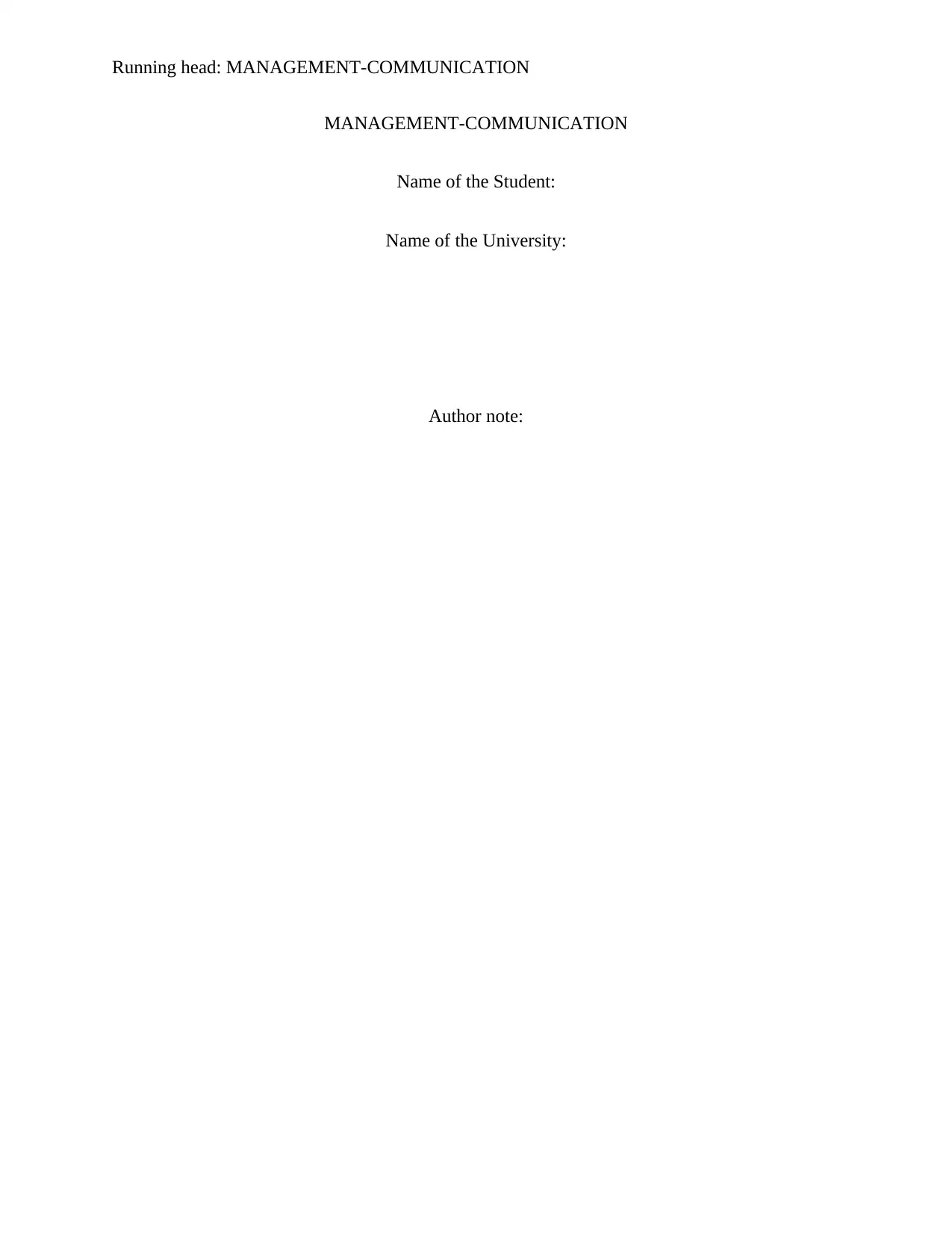
Running head: MANAGEMENT-COMMUNICATION
MANAGEMENT-COMMUNICATION
Name of the Student:
Name of the University:
Author note:
MANAGEMENT-COMMUNICATION
Name of the Student:
Name of the University:
Author note:
Paraphrase This Document
Need a fresh take? Get an instant paraphrase of this document with our AI Paraphraser
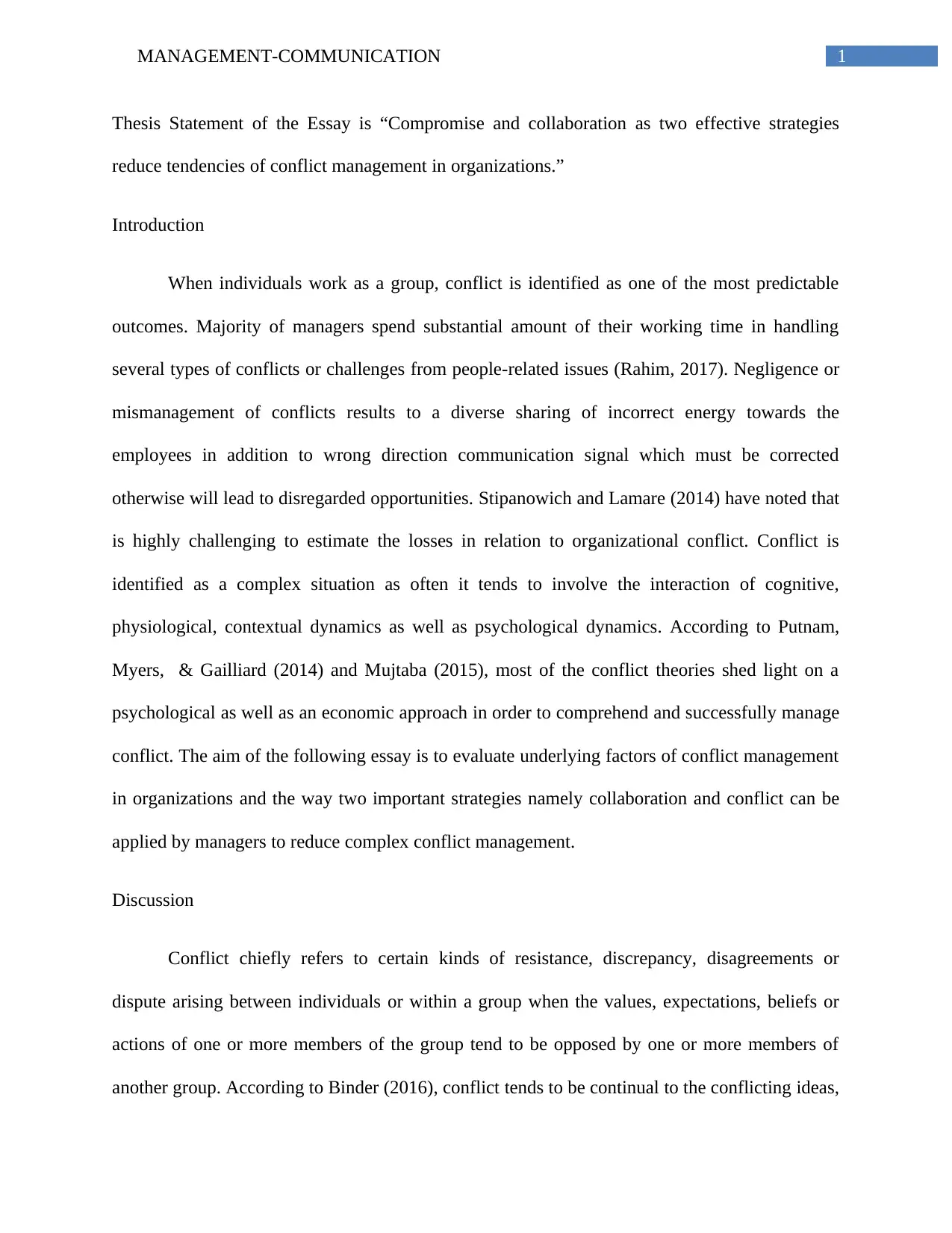
1MANAGEMENT-COMMUNICATION
Thesis Statement of the Essay is “Compromise and collaboration as two effective strategies
reduce tendencies of conflict management in organizations.”
Introduction
When individuals work as a group, conflict is identified as one of the most predictable
outcomes. Majority of managers spend substantial amount of their working time in handling
several types of conflicts or challenges from people-related issues (Rahim, 2017). Negligence or
mismanagement of conflicts results to a diverse sharing of incorrect energy towards the
employees in addition to wrong direction communication signal which must be corrected
otherwise will lead to disregarded opportunities. Stipanowich and Lamare (2014) have noted that
is highly challenging to estimate the losses in relation to organizational conflict. Conflict is
identified as a complex situation as often it tends to involve the interaction of cognitive,
physiological, contextual dynamics as well as psychological dynamics. According to Putnam,
Myers, & Gailliard (2014) and Mujtaba (2015), most of the conflict theories shed light on a
psychological as well as an economic approach in order to comprehend and successfully manage
conflict. The aim of the following essay is to evaluate underlying factors of conflict management
in organizations and the way two important strategies namely collaboration and conflict can be
applied by managers to reduce complex conflict management.
Discussion
Conflict chiefly refers to certain kinds of resistance, discrepancy, disagreements or
dispute arising between individuals or within a group when the values, expectations, beliefs or
actions of one or more members of the group tend to be opposed by one or more members of
another group. According to Binder (2016), conflict tends to be continual to the conflicting ideas,
Thesis Statement of the Essay is “Compromise and collaboration as two effective strategies
reduce tendencies of conflict management in organizations.”
Introduction
When individuals work as a group, conflict is identified as one of the most predictable
outcomes. Majority of managers spend substantial amount of their working time in handling
several types of conflicts or challenges from people-related issues (Rahim, 2017). Negligence or
mismanagement of conflicts results to a diverse sharing of incorrect energy towards the
employees in addition to wrong direction communication signal which must be corrected
otherwise will lead to disregarded opportunities. Stipanowich and Lamare (2014) have noted that
is highly challenging to estimate the losses in relation to organizational conflict. Conflict is
identified as a complex situation as often it tends to involve the interaction of cognitive,
physiological, contextual dynamics as well as psychological dynamics. According to Putnam,
Myers, & Gailliard (2014) and Mujtaba (2015), most of the conflict theories shed light on a
psychological as well as an economic approach in order to comprehend and successfully manage
conflict. The aim of the following essay is to evaluate underlying factors of conflict management
in organizations and the way two important strategies namely collaboration and conflict can be
applied by managers to reduce complex conflict management.
Discussion
Conflict chiefly refers to certain kinds of resistance, discrepancy, disagreements or
dispute arising between individuals or within a group when the values, expectations, beliefs or
actions of one or more members of the group tend to be opposed by one or more members of
another group. According to Binder (2016), conflict tends to be continual to the conflicting ideas,
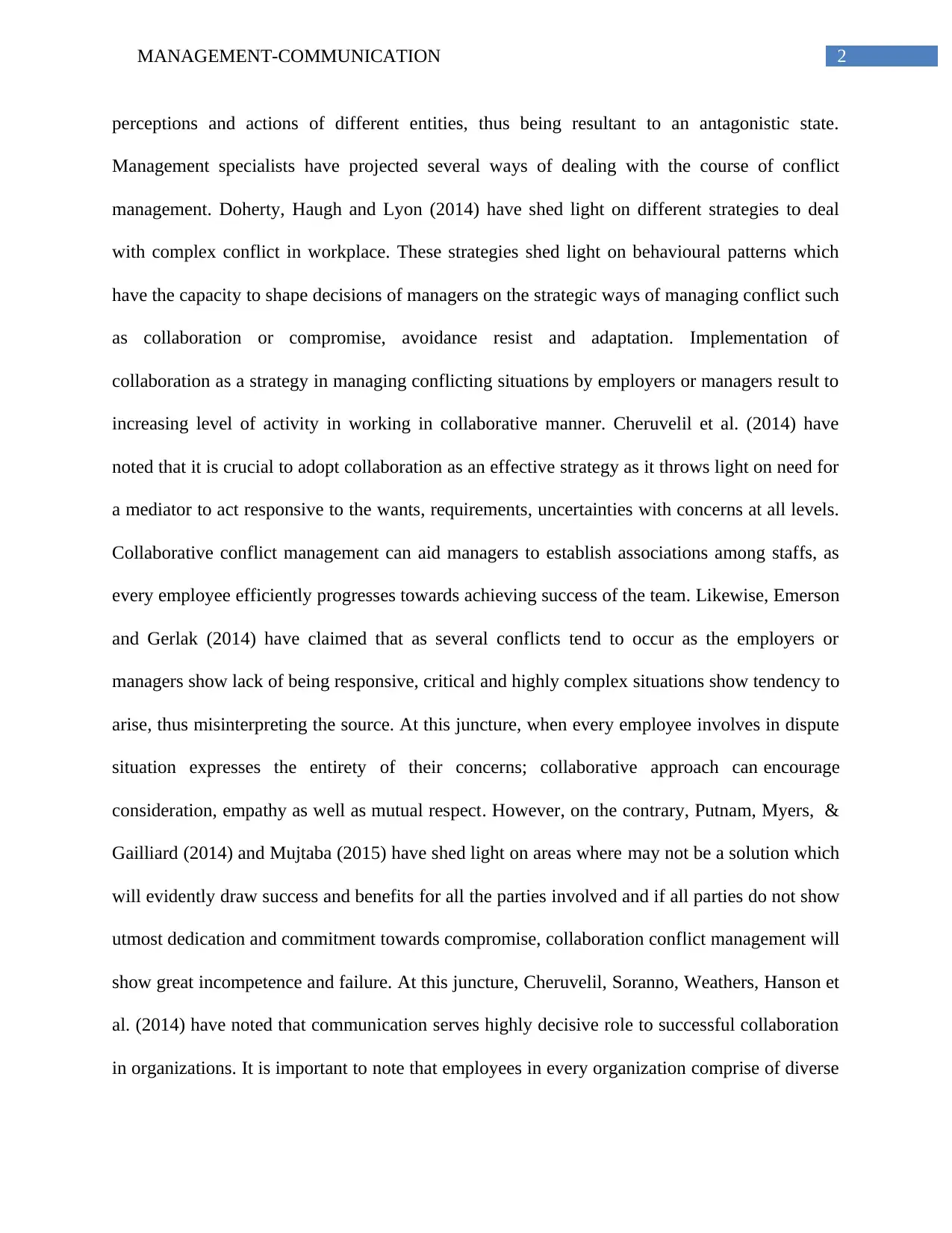
2MANAGEMENT-COMMUNICATION
perceptions and actions of different entities, thus being resultant to an antagonistic state.
Management specialists have projected several ways of dealing with the course of conflict
management. Doherty, Haugh and Lyon (2014) have shed light on different strategies to deal
with complex conflict in workplace. These strategies shed light on behavioural patterns which
have the capacity to shape decisions of managers on the strategic ways of managing conflict such
as collaboration or compromise, avoidance resist and adaptation. Implementation of
collaboration as a strategy in managing conflicting situations by employers or managers result to
increasing level of activity in working in collaborative manner. Cheruvelil et al. (2014) have
noted that it is crucial to adopt collaboration as an effective strategy as it throws light on need for
a mediator to act responsive to the wants, requirements, uncertainties with concerns at all levels.
Collaborative conflict management can aid managers to establish associations among staffs, as
every employee efficiently progresses towards achieving success of the team. Likewise, Emerson
and Gerlak (2014) have claimed that as several conflicts tend to occur as the employers or
managers show lack of being responsive, critical and highly complex situations show tendency to
arise, thus misinterpreting the source. At this juncture, when every employee involves in dispute
situation expresses the entirety of their concerns; collaborative approach can encourage
consideration, empathy as well as mutual respect. However, on the contrary, Putnam, Myers, &
Gailliard (2014) and Mujtaba (2015) have shed light on areas where may not be a solution which
will evidently draw success and benefits for all the parties involved and if all parties do not show
utmost dedication and commitment towards compromise, collaboration conflict management will
show great incompetence and failure. At this juncture, Cheruvelil, Soranno, Weathers, Hanson et
al. (2014) have noted that communication serves highly decisive role to successful collaboration
in organizations. It is important to note that employees in every organization comprise of diverse
perceptions and actions of different entities, thus being resultant to an antagonistic state.
Management specialists have projected several ways of dealing with the course of conflict
management. Doherty, Haugh and Lyon (2014) have shed light on different strategies to deal
with complex conflict in workplace. These strategies shed light on behavioural patterns which
have the capacity to shape decisions of managers on the strategic ways of managing conflict such
as collaboration or compromise, avoidance resist and adaptation. Implementation of
collaboration as a strategy in managing conflicting situations by employers or managers result to
increasing level of activity in working in collaborative manner. Cheruvelil et al. (2014) have
noted that it is crucial to adopt collaboration as an effective strategy as it throws light on need for
a mediator to act responsive to the wants, requirements, uncertainties with concerns at all levels.
Collaborative conflict management can aid managers to establish associations among staffs, as
every employee efficiently progresses towards achieving success of the team. Likewise, Emerson
and Gerlak (2014) have claimed that as several conflicts tend to occur as the employers or
managers show lack of being responsive, critical and highly complex situations show tendency to
arise, thus misinterpreting the source. At this juncture, when every employee involves in dispute
situation expresses the entirety of their concerns; collaborative approach can encourage
consideration, empathy as well as mutual respect. However, on the contrary, Putnam, Myers, &
Gailliard (2014) and Mujtaba (2015) have shed light on areas where may not be a solution which
will evidently draw success and benefits for all the parties involved and if all parties do not show
utmost dedication and commitment towards compromise, collaboration conflict management will
show great incompetence and failure. At this juncture, Cheruvelil, Soranno, Weathers, Hanson et
al. (2014) have noted that communication serves highly decisive role to successful collaboration
in organizations. It is important to note that employees in every organization comprise of diverse
⊘ This is a preview!⊘
Do you want full access?
Subscribe today to unlock all pages.

Trusted by 1+ million students worldwide
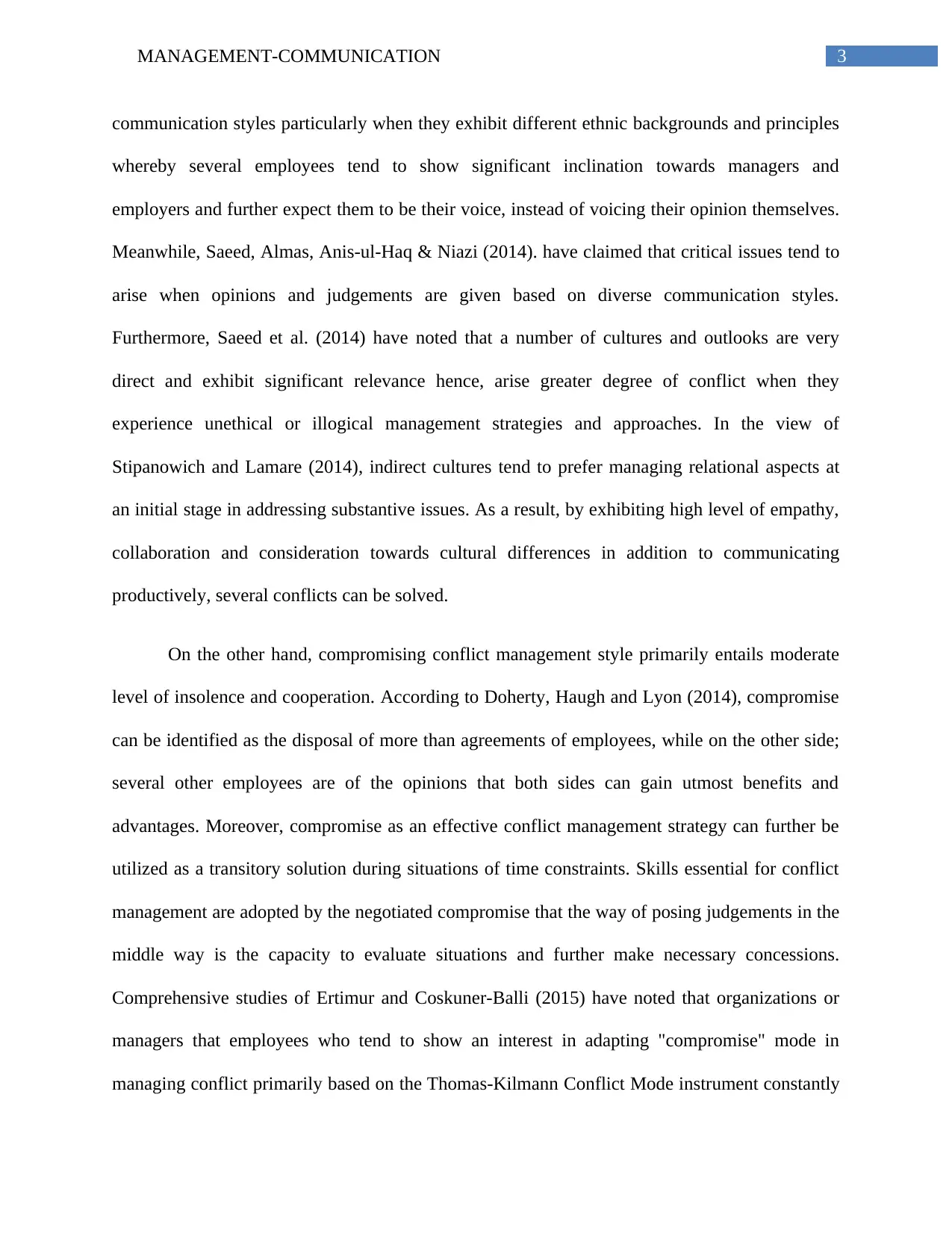
3MANAGEMENT-COMMUNICATION
communication styles particularly when they exhibit different ethnic backgrounds and principles
whereby several employees tend to show significant inclination towards managers and
employers and further expect them to be their voice, instead of voicing their opinion themselves.
Meanwhile, Saeed, Almas, Anis-ul-Haq & Niazi (2014). have claimed that critical issues tend to
arise when opinions and judgements are given based on diverse communication styles.
Furthermore, Saeed et al. (2014) have noted that a number of cultures and outlooks are very
direct and exhibit significant relevance hence, arise greater degree of conflict when they
experience unethical or illogical management strategies and approaches. In the view of
Stipanowich and Lamare (2014), indirect cultures tend to prefer managing relational aspects at
an initial stage in addressing substantive issues. As a result, by exhibiting high level of empathy,
collaboration and consideration towards cultural differences in addition to communicating
productively, several conflicts can be solved.
On the other hand, compromising conflict management style primarily entails moderate
level of insolence and cooperation. According to Doherty, Haugh and Lyon (2014), compromise
can be identified as the disposal of more than agreements of employees, while on the other side;
several other employees are of the opinions that both sides can gain utmost benefits and
advantages. Moreover, compromise as an effective conflict management strategy can further be
utilized as a transitory solution during situations of time constraints. Skills essential for conflict
management are adopted by the negotiated compromise that the way of posing judgements in the
middle way is the capacity to evaluate situations and further make necessary concessions.
Comprehensive studies of Ertimur and Coskuner-Balli (2015) have noted that organizations or
managers that employees who tend to show an interest in adapting "compromise" mode in
managing conflict primarily based on the Thomas-Kilmann Conflict Mode instrument constantly
communication styles particularly when they exhibit different ethnic backgrounds and principles
whereby several employees tend to show significant inclination towards managers and
employers and further expect them to be their voice, instead of voicing their opinion themselves.
Meanwhile, Saeed, Almas, Anis-ul-Haq & Niazi (2014). have claimed that critical issues tend to
arise when opinions and judgements are given based on diverse communication styles.
Furthermore, Saeed et al. (2014) have noted that a number of cultures and outlooks are very
direct and exhibit significant relevance hence, arise greater degree of conflict when they
experience unethical or illogical management strategies and approaches. In the view of
Stipanowich and Lamare (2014), indirect cultures tend to prefer managing relational aspects at
an initial stage in addressing substantive issues. As a result, by exhibiting high level of empathy,
collaboration and consideration towards cultural differences in addition to communicating
productively, several conflicts can be solved.
On the other hand, compromising conflict management style primarily entails moderate
level of insolence and cooperation. According to Doherty, Haugh and Lyon (2014), compromise
can be identified as the disposal of more than agreements of employees, while on the other side;
several other employees are of the opinions that both sides can gain utmost benefits and
advantages. Moreover, compromise as an effective conflict management strategy can further be
utilized as a transitory solution during situations of time constraints. Skills essential for conflict
management are adopted by the negotiated compromise that the way of posing judgements in the
middle way is the capacity to evaluate situations and further make necessary concessions.
Comprehensive studies of Ertimur and Coskuner-Balli (2015) have noted that organizations or
managers that employees who tend to show an interest in adapting "compromise" mode in
managing conflict primarily based on the Thomas-Kilmann Conflict Mode instrument constantly
Paraphrase This Document
Need a fresh take? Get an instant paraphrase of this document with our AI Paraphraser
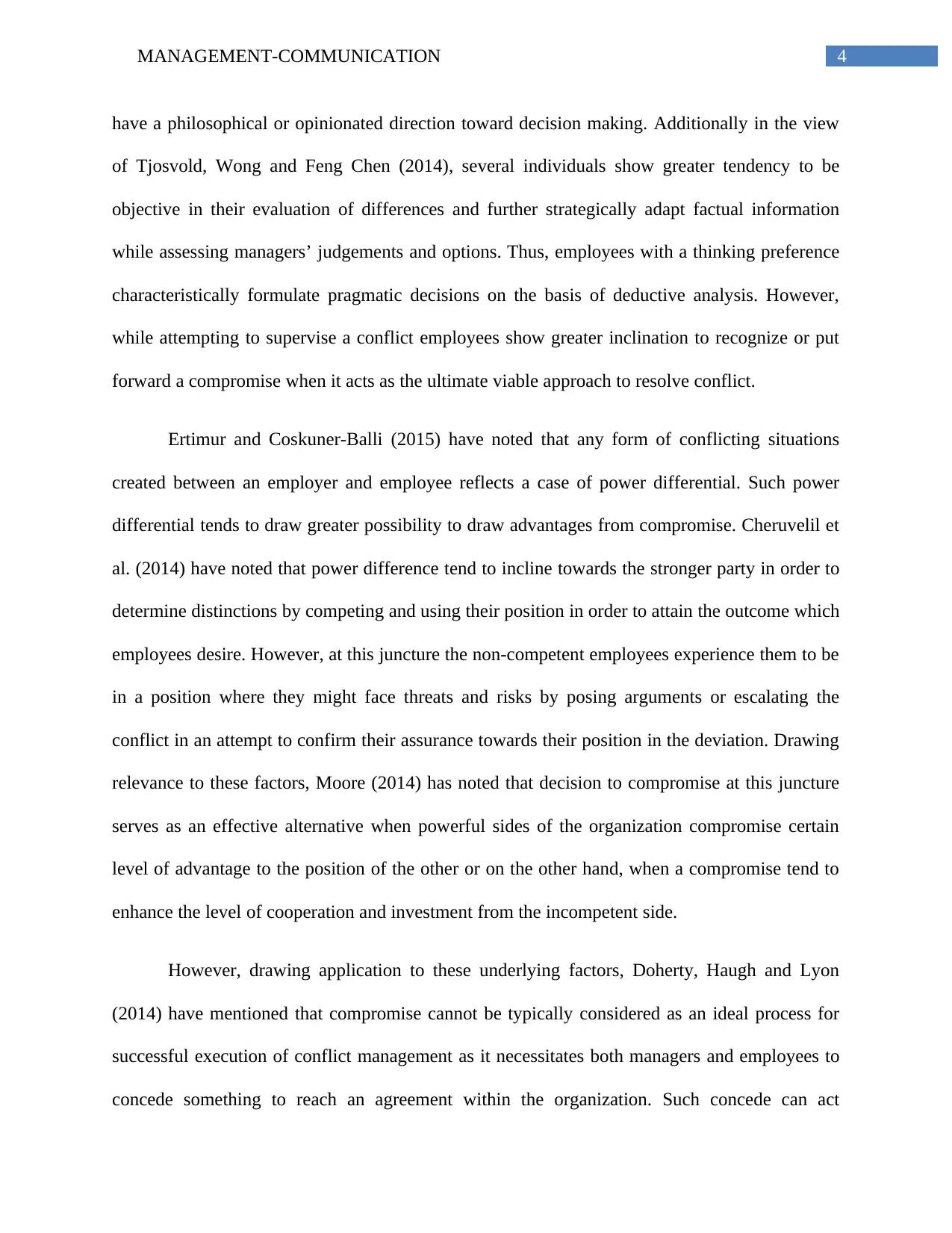
4MANAGEMENT-COMMUNICATION
have a philosophical or opinionated direction toward decision making. Additionally in the view
of Tjosvold, Wong and Feng Chen (2014), several individuals show greater tendency to be
objective in their evaluation of differences and further strategically adapt factual information
while assessing managers’ judgements and options. Thus, employees with a thinking preference
characteristically formulate pragmatic decisions on the basis of deductive analysis. However,
while attempting to supervise a conflict employees show greater inclination to recognize or put
forward a compromise when it acts as the ultimate viable approach to resolve conflict.
Ertimur and Coskuner-Balli (2015) have noted that any form of conflicting situations
created between an employer and employee reflects a case of power differential. Such power
differential tends to draw greater possibility to draw advantages from compromise. Cheruvelil et
al. (2014) have noted that power difference tend to incline towards the stronger party in order to
determine distinctions by competing and using their position in order to attain the outcome which
employees desire. However, at this juncture the non-competent employees experience them to be
in a position where they might face threats and risks by posing arguments or escalating the
conflict in an attempt to confirm their assurance towards their position in the deviation. Drawing
relevance to these factors, Moore (2014) has noted that decision to compromise at this juncture
serves as an effective alternative when powerful sides of the organization compromise certain
level of advantage to the position of the other or on the other hand, when a compromise tend to
enhance the level of cooperation and investment from the incompetent side.
However, drawing application to these underlying factors, Doherty, Haugh and Lyon
(2014) have mentioned that compromise cannot be typically considered as an ideal process for
successful execution of conflict management as it necessitates both managers and employees to
concede something to reach an agreement within the organization. Such concede can act
have a philosophical or opinionated direction toward decision making. Additionally in the view
of Tjosvold, Wong and Feng Chen (2014), several individuals show greater tendency to be
objective in their evaluation of differences and further strategically adapt factual information
while assessing managers’ judgements and options. Thus, employees with a thinking preference
characteristically formulate pragmatic decisions on the basis of deductive analysis. However,
while attempting to supervise a conflict employees show greater inclination to recognize or put
forward a compromise when it acts as the ultimate viable approach to resolve conflict.
Ertimur and Coskuner-Balli (2015) have noted that any form of conflicting situations
created between an employer and employee reflects a case of power differential. Such power
differential tends to draw greater possibility to draw advantages from compromise. Cheruvelil et
al. (2014) have noted that power difference tend to incline towards the stronger party in order to
determine distinctions by competing and using their position in order to attain the outcome which
employees desire. However, at this juncture the non-competent employees experience them to be
in a position where they might face threats and risks by posing arguments or escalating the
conflict in an attempt to confirm their assurance towards their position in the deviation. Drawing
relevance to these factors, Moore (2014) has noted that decision to compromise at this juncture
serves as an effective alternative when powerful sides of the organization compromise certain
level of advantage to the position of the other or on the other hand, when a compromise tend to
enhance the level of cooperation and investment from the incompetent side.
However, drawing application to these underlying factors, Doherty, Haugh and Lyon
(2014) have mentioned that compromise cannot be typically considered as an ideal process for
successful execution of conflict management as it necessitates both managers and employees to
concede something to reach an agreement within the organization. Such concede can act
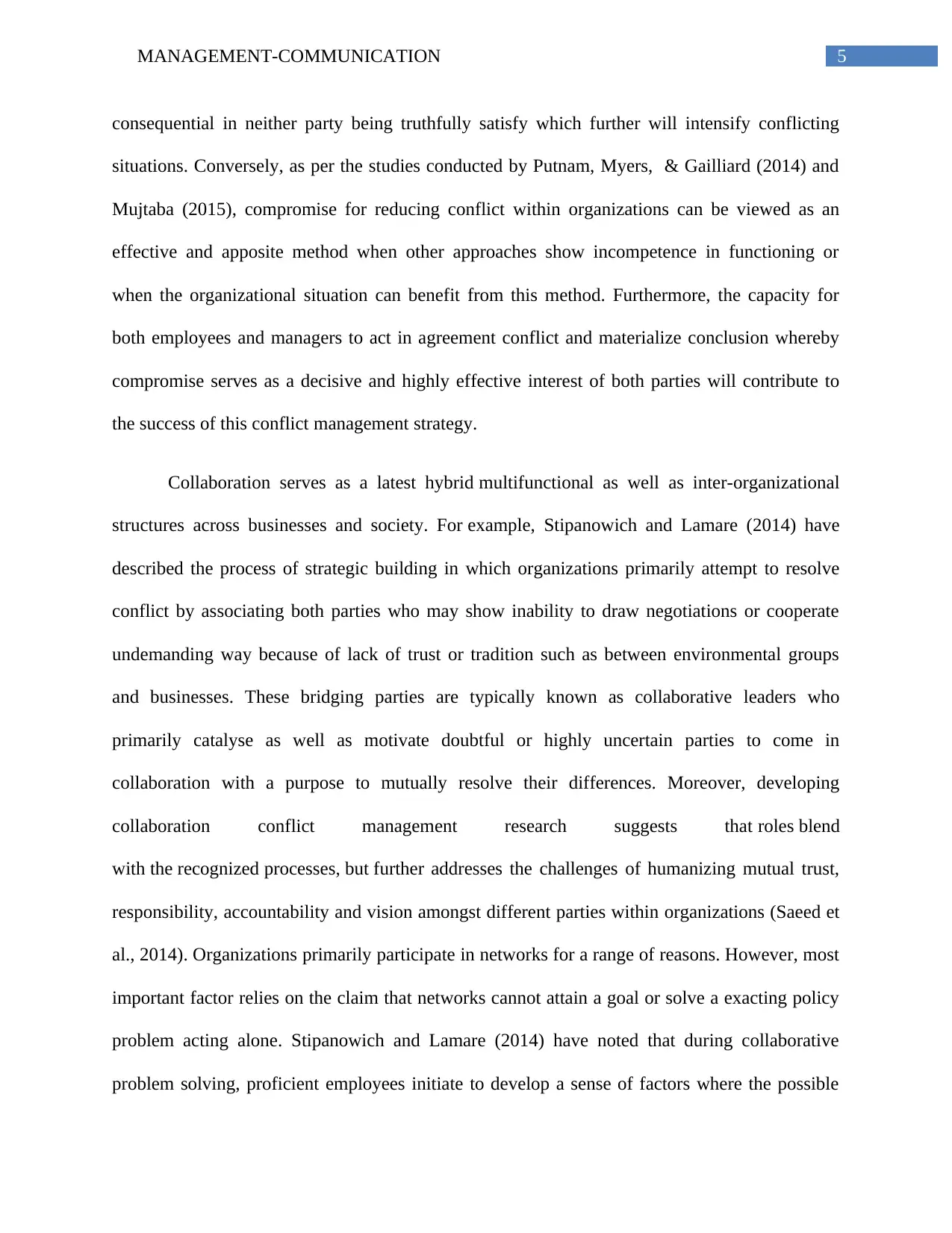
5MANAGEMENT-COMMUNICATION
consequential in neither party being truthfully satisfy which further will intensify conflicting
situations. Conversely, as per the studies conducted by Putnam, Myers, & Gailliard (2014) and
Mujtaba (2015), compromise for reducing conflict within organizations can be viewed as an
effective and apposite method when other approaches show incompetence in functioning or
when the organizational situation can benefit from this method. Furthermore, the capacity for
both employees and managers to act in agreement conflict and materialize conclusion whereby
compromise serves as a decisive and highly effective interest of both parties will contribute to
the success of this conflict management strategy.
Collaboration serves as a latest hybrid multifunctional as well as inter-organizational
structures across businesses and society. For example, Stipanowich and Lamare (2014) have
described the process of strategic building in which organizations primarily attempt to resolve
conflict by associating both parties who may show inability to draw negotiations or cooperate
undemanding way because of lack of trust or tradition such as between environmental groups
and businesses. These bridging parties are typically known as collaborative leaders who
primarily catalyse as well as motivate doubtful or highly uncertain parties to come in
collaboration with a purpose to mutually resolve their differences. Moreover, developing
collaboration conflict management research suggests that roles blend
with the recognized processes, but further addresses the challenges of humanizing mutual trust,
responsibility, accountability and vision amongst different parties within organizations (Saeed et
al., 2014). Organizations primarily participate in networks for a range of reasons. However, most
important factor relies on the claim that networks cannot attain a goal or solve a exacting policy
problem acting alone. Stipanowich and Lamare (2014) have noted that during collaborative
problem solving, proficient employees initiate to develop a sense of factors where the possible
consequential in neither party being truthfully satisfy which further will intensify conflicting
situations. Conversely, as per the studies conducted by Putnam, Myers, & Gailliard (2014) and
Mujtaba (2015), compromise for reducing conflict within organizations can be viewed as an
effective and apposite method when other approaches show incompetence in functioning or
when the organizational situation can benefit from this method. Furthermore, the capacity for
both employees and managers to act in agreement conflict and materialize conclusion whereby
compromise serves as a decisive and highly effective interest of both parties will contribute to
the success of this conflict management strategy.
Collaboration serves as a latest hybrid multifunctional as well as inter-organizational
structures across businesses and society. For example, Stipanowich and Lamare (2014) have
described the process of strategic building in which organizations primarily attempt to resolve
conflict by associating both parties who may show inability to draw negotiations or cooperate
undemanding way because of lack of trust or tradition such as between environmental groups
and businesses. These bridging parties are typically known as collaborative leaders who
primarily catalyse as well as motivate doubtful or highly uncertain parties to come in
collaboration with a purpose to mutually resolve their differences. Moreover, developing
collaboration conflict management research suggests that roles blend
with the recognized processes, but further addresses the challenges of humanizing mutual trust,
responsibility, accountability and vision amongst different parties within organizations (Saeed et
al., 2014). Organizations primarily participate in networks for a range of reasons. However, most
important factor relies on the claim that networks cannot attain a goal or solve a exacting policy
problem acting alone. Stipanowich and Lamare (2014) have noted that during collaborative
problem solving, proficient employees initiate to develop a sense of factors where the possible
⊘ This is a preview!⊘
Do you want full access?
Subscribe today to unlock all pages.

Trusted by 1+ million students worldwide
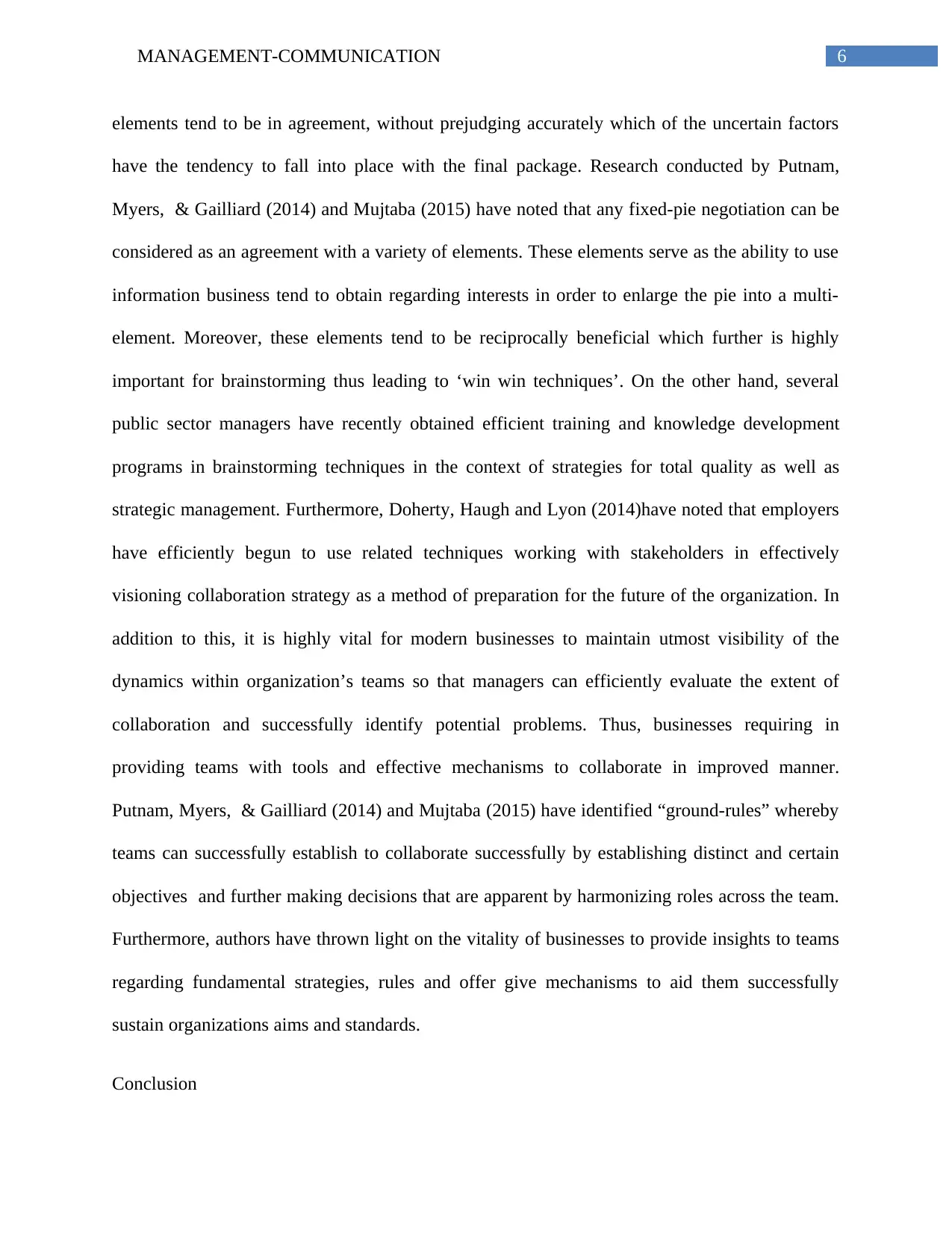
6MANAGEMENT-COMMUNICATION
elements tend to be in agreement, without prejudging accurately which of the uncertain factors
have the tendency to fall into place with the final package. Research conducted by Putnam,
Myers, & Gailliard (2014) and Mujtaba (2015) have noted that any fixed-pie negotiation can be
considered as an agreement with a variety of elements. These elements serve as the ability to use
information business tend to obtain regarding interests in order to enlarge the pie into a multi-
element. Moreover, these elements tend to be reciprocally beneficial which further is highly
important for brainstorming thus leading to ‘win win techniques’. On the other hand, several
public sector managers have recently obtained efficient training and knowledge development
programs in brainstorming techniques in the context of strategies for total quality as well as
strategic management. Furthermore, Doherty, Haugh and Lyon (2014)have noted that employers
have efficiently begun to use related techniques working with stakeholders in effectively
visioning collaboration strategy as a method of preparation for the future of the organization. In
addition to this, it is highly vital for modern businesses to maintain utmost visibility of the
dynamics within organization’s teams so that managers can efficiently evaluate the extent of
collaboration and successfully identify potential problems. Thus, businesses requiring in
providing teams with tools and effective mechanisms to collaborate in improved manner.
Putnam, Myers, & Gailliard (2014) and Mujtaba (2015) have identified “ground-rules” whereby
teams can successfully establish to collaborate successfully by establishing distinct and certain
objectives and further making decisions that are apparent by harmonizing roles across the team.
Furthermore, authors have thrown light on the vitality of businesses to provide insights to teams
regarding fundamental strategies, rules and offer give mechanisms to aid them successfully
sustain organizations aims and standards.
Conclusion
elements tend to be in agreement, without prejudging accurately which of the uncertain factors
have the tendency to fall into place with the final package. Research conducted by Putnam,
Myers, & Gailliard (2014) and Mujtaba (2015) have noted that any fixed-pie negotiation can be
considered as an agreement with a variety of elements. These elements serve as the ability to use
information business tend to obtain regarding interests in order to enlarge the pie into a multi-
element. Moreover, these elements tend to be reciprocally beneficial which further is highly
important for brainstorming thus leading to ‘win win techniques’. On the other hand, several
public sector managers have recently obtained efficient training and knowledge development
programs in brainstorming techniques in the context of strategies for total quality as well as
strategic management. Furthermore, Doherty, Haugh and Lyon (2014)have noted that employers
have efficiently begun to use related techniques working with stakeholders in effectively
visioning collaboration strategy as a method of preparation for the future of the organization. In
addition to this, it is highly vital for modern businesses to maintain utmost visibility of the
dynamics within organization’s teams so that managers can efficiently evaluate the extent of
collaboration and successfully identify potential problems. Thus, businesses requiring in
providing teams with tools and effective mechanisms to collaborate in improved manner.
Putnam, Myers, & Gailliard (2014) and Mujtaba (2015) have identified “ground-rules” whereby
teams can successfully establish to collaborate successfully by establishing distinct and certain
objectives and further making decisions that are apparent by harmonizing roles across the team.
Furthermore, authors have thrown light on the vitality of businesses to provide insights to teams
regarding fundamental strategies, rules and offer give mechanisms to aid them successfully
sustain organizations aims and standards.
Conclusion
Paraphrase This Document
Need a fresh take? Get an instant paraphrase of this document with our AI Paraphraser

7MANAGEMENT-COMMUNICATION
Hence to conclude, viewpoint of a persistent reform of management relies on the
essentiality of change of directions as well as enhancement to efficiently professionalize issues
with conflict management. However, developing responsiveness and knowledge of managers
regarding the importance of internal communication at upward as well as downward level in
addition to the necessitation of "listening as well as interpreting the pulse” of the organization.
Thus, by efficiently creating a collaborative environment and by rising organizational awareness
as well as generating team strength and fortitude which shares widespread goals efficiently
ensure an effective performance of employees.
Hence to conclude, viewpoint of a persistent reform of management relies on the
essentiality of change of directions as well as enhancement to efficiently professionalize issues
with conflict management. However, developing responsiveness and knowledge of managers
regarding the importance of internal communication at upward as well as downward level in
addition to the necessitation of "listening as well as interpreting the pulse” of the organization.
Thus, by efficiently creating a collaborative environment and by rising organizational awareness
as well as generating team strength and fortitude which shares widespread goals efficiently
ensure an effective performance of employees.
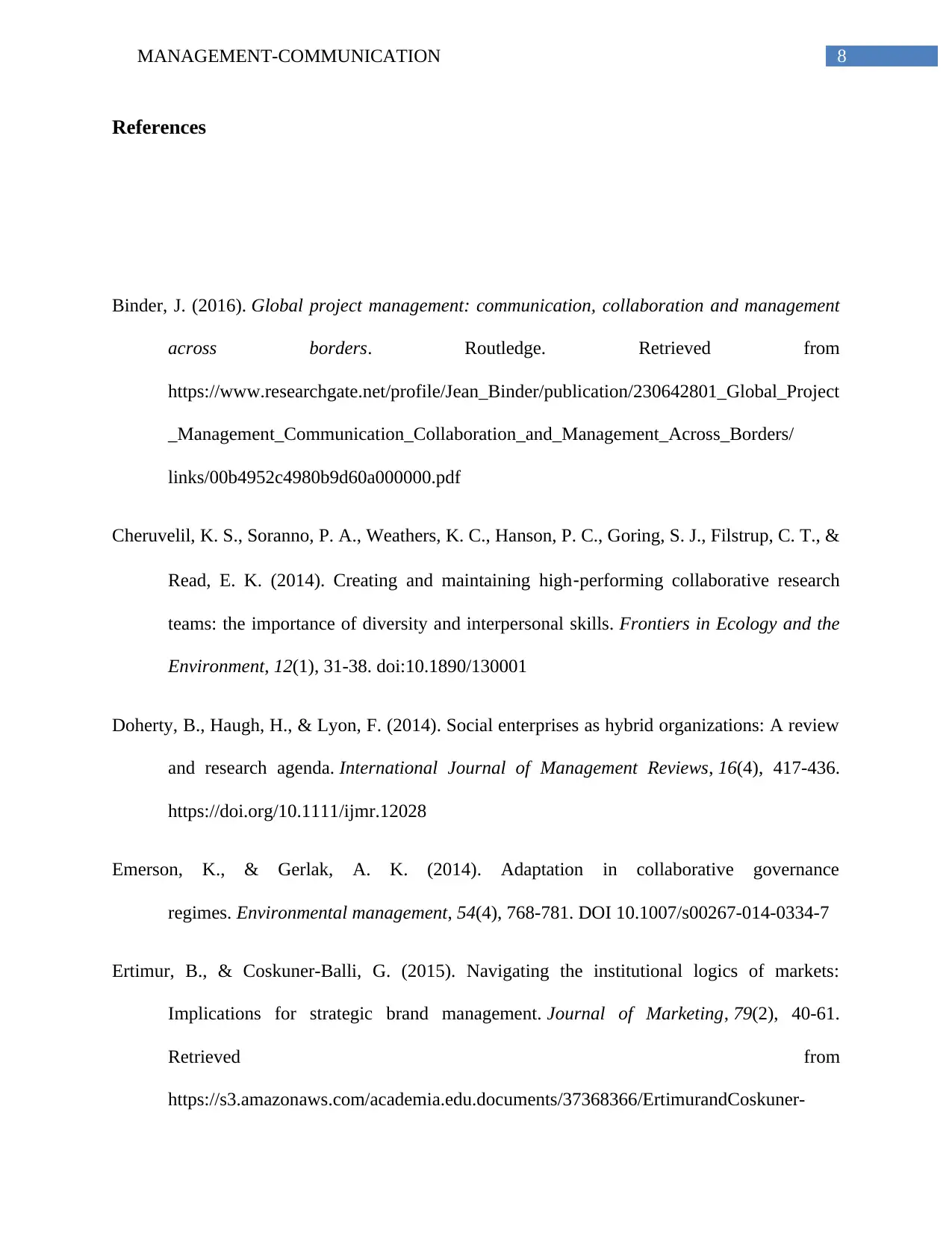
8MANAGEMENT-COMMUNICATION
References
Binder, J. (2016). Global project management: communication, collaboration and management
across borders. Routledge. Retrieved from
https://www.researchgate.net/profile/Jean_Binder/publication/230642801_Global_Project
_Management_Communication_Collaboration_and_Management_Across_Borders/
links/00b4952c4980b9d60a000000.pdf
Cheruvelil, K. S., Soranno, P. A., Weathers, K. C., Hanson, P. C., Goring, S. J., Filstrup, C. T., &
Read, E. K. (2014). Creating and maintaining high‐performing collaborative research
teams: the importance of diversity and interpersonal skills. Frontiers in Ecology and the
Environment, 12(1), 31-38. doi:10.1890/130001
Doherty, B., Haugh, H., & Lyon, F. (2014). Social enterprises as hybrid organizations: A review
and research agenda. International Journal of Management Reviews, 16(4), 417-436.
https://doi.org/10.1111/ijmr.12028
Emerson, K., & Gerlak, A. K. (2014). Adaptation in collaborative governance
regimes. Environmental management, 54(4), 768-781. DOI 10.1007/s00267-014-0334-7
Ertimur, B., & Coskuner-Balli, G. (2015). Navigating the institutional logics of markets:
Implications for strategic brand management. Journal of Marketing, 79(2), 40-61.
Retrieved from
https://s3.amazonaws.com/academia.edu.documents/37368366/ErtimurandCoskuner-
References
Binder, J. (2016). Global project management: communication, collaboration and management
across borders. Routledge. Retrieved from
https://www.researchgate.net/profile/Jean_Binder/publication/230642801_Global_Project
_Management_Communication_Collaboration_and_Management_Across_Borders/
links/00b4952c4980b9d60a000000.pdf
Cheruvelil, K. S., Soranno, P. A., Weathers, K. C., Hanson, P. C., Goring, S. J., Filstrup, C. T., &
Read, E. K. (2014). Creating and maintaining high‐performing collaborative research
teams: the importance of diversity and interpersonal skills. Frontiers in Ecology and the
Environment, 12(1), 31-38. doi:10.1890/130001
Doherty, B., Haugh, H., & Lyon, F. (2014). Social enterprises as hybrid organizations: A review
and research agenda. International Journal of Management Reviews, 16(4), 417-436.
https://doi.org/10.1111/ijmr.12028
Emerson, K., & Gerlak, A. K. (2014). Adaptation in collaborative governance
regimes. Environmental management, 54(4), 768-781. DOI 10.1007/s00267-014-0334-7
Ertimur, B., & Coskuner-Balli, G. (2015). Navigating the institutional logics of markets:
Implications for strategic brand management. Journal of Marketing, 79(2), 40-61.
Retrieved from
https://s3.amazonaws.com/academia.edu.documents/37368366/ErtimurandCoskuner-
⊘ This is a preview!⊘
Do you want full access?
Subscribe today to unlock all pages.

Trusted by 1+ million students worldwide
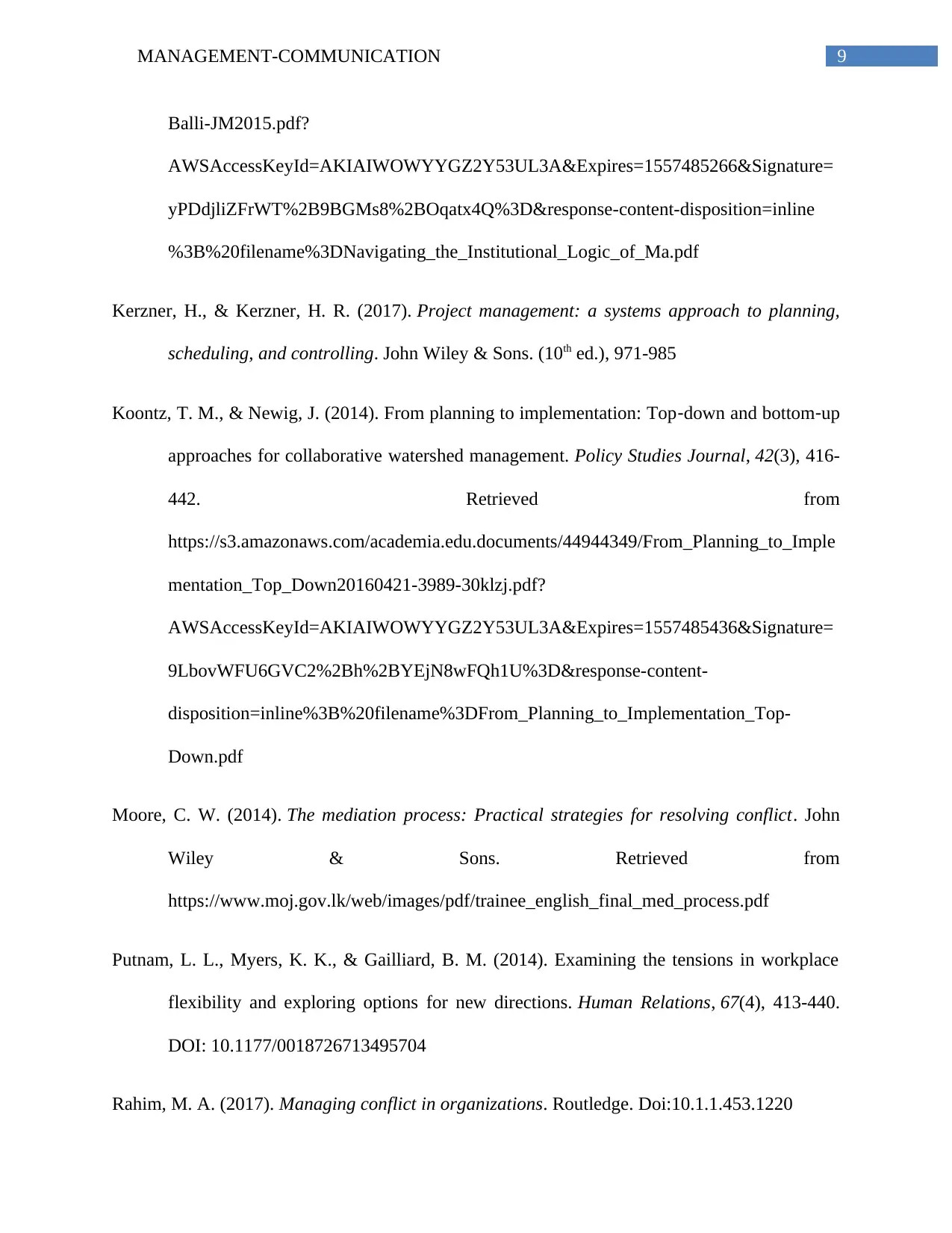
9MANAGEMENT-COMMUNICATION
Balli-JM2015.pdf?
AWSAccessKeyId=AKIAIWOWYYGZ2Y53UL3A&Expires=1557485266&Signature=
yPDdjliZFrWT%2B9BGMs8%2BOqatx4Q%3D&response-content-disposition=inline
%3B%20filename%3DNavigating_the_Institutional_Logic_of_Ma.pdf
Kerzner, H., & Kerzner, H. R. (2017). Project management: a systems approach to planning,
scheduling, and controlling. John Wiley & Sons. (10th ed.), 971-985
Koontz, T. M., & Newig, J. (2014). From planning to implementation: Top‐down and bottom‐up
approaches for collaborative watershed management. Policy Studies Journal, 42(3), 416-
442. Retrieved from
https://s3.amazonaws.com/academia.edu.documents/44944349/From_Planning_to_Imple
mentation_Top_Down20160421-3989-30klzj.pdf?
AWSAccessKeyId=AKIAIWOWYYGZ2Y53UL3A&Expires=1557485436&Signature=
9LbovWFU6GVC2%2Bh%2BYEjN8wFQh1U%3D&response-content-
disposition=inline%3B%20filename%3DFrom_Planning_to_Implementation_Top-
Down.pdf
Moore, C. W. (2014). The mediation process: Practical strategies for resolving conflict. John
Wiley & Sons. Retrieved from
https://www.moj.gov.lk/web/images/pdf/trainee_english_final_med_process.pdf
Putnam, L. L., Myers, K. K., & Gailliard, B. M. (2014). Examining the tensions in workplace
flexibility and exploring options for new directions. Human Relations, 67(4), 413-440.
DOI: 10.1177/0018726713495704
Rahim, M. A. (2017). Managing conflict in organizations. Routledge. Doi:10.1.1.453.1220
Balli-JM2015.pdf?
AWSAccessKeyId=AKIAIWOWYYGZ2Y53UL3A&Expires=1557485266&Signature=
yPDdjliZFrWT%2B9BGMs8%2BOqatx4Q%3D&response-content-disposition=inline
%3B%20filename%3DNavigating_the_Institutional_Logic_of_Ma.pdf
Kerzner, H., & Kerzner, H. R. (2017). Project management: a systems approach to planning,
scheduling, and controlling. John Wiley & Sons. (10th ed.), 971-985
Koontz, T. M., & Newig, J. (2014). From planning to implementation: Top‐down and bottom‐up
approaches for collaborative watershed management. Policy Studies Journal, 42(3), 416-
442. Retrieved from
https://s3.amazonaws.com/academia.edu.documents/44944349/From_Planning_to_Imple
mentation_Top_Down20160421-3989-30klzj.pdf?
AWSAccessKeyId=AKIAIWOWYYGZ2Y53UL3A&Expires=1557485436&Signature=
9LbovWFU6GVC2%2Bh%2BYEjN8wFQh1U%3D&response-content-
disposition=inline%3B%20filename%3DFrom_Planning_to_Implementation_Top-
Down.pdf
Moore, C. W. (2014). The mediation process: Practical strategies for resolving conflict. John
Wiley & Sons. Retrieved from
https://www.moj.gov.lk/web/images/pdf/trainee_english_final_med_process.pdf
Putnam, L. L., Myers, K. K., & Gailliard, B. M. (2014). Examining the tensions in workplace
flexibility and exploring options for new directions. Human Relations, 67(4), 413-440.
DOI: 10.1177/0018726713495704
Rahim, M. A. (2017). Managing conflict in organizations. Routledge. Doi:10.1.1.453.1220
Paraphrase This Document
Need a fresh take? Get an instant paraphrase of this document with our AI Paraphraser
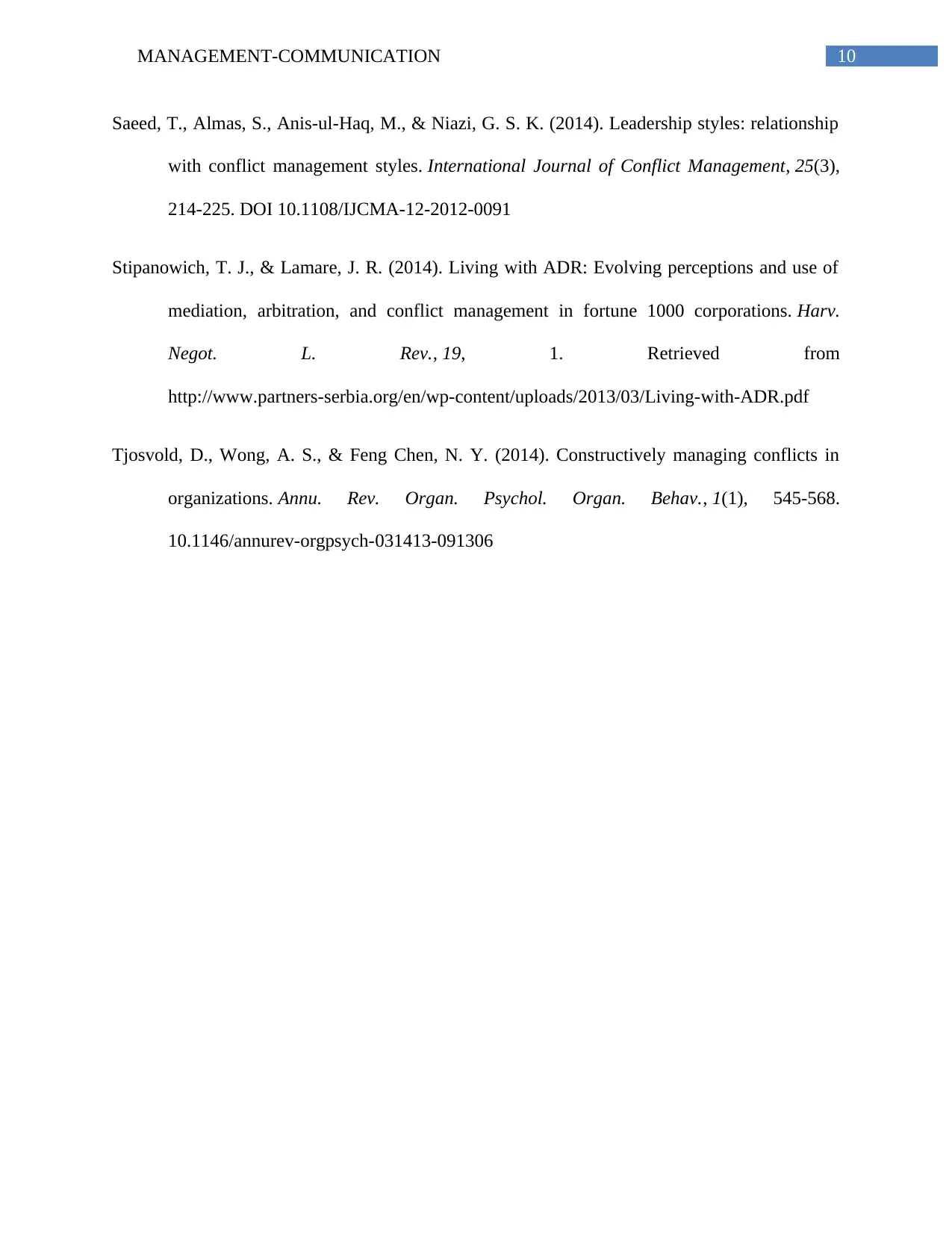
10MANAGEMENT-COMMUNICATION
Saeed, T., Almas, S., Anis-ul-Haq, M., & Niazi, G. S. K. (2014). Leadership styles: relationship
with conflict management styles. International Journal of Conflict Management, 25(3),
214-225. DOI 10.1108/IJCMA-12-2012-0091
Stipanowich, T. J., & Lamare, J. R. (2014). Living with ADR: Evolving perceptions and use of
mediation, arbitration, and conflict management in fortune 1000 corporations. Harv.
Negot. L. Rev., 19, 1. Retrieved from
http://www.partners-serbia.org/en/wp-content/uploads/2013/03/Living-with-ADR.pdf
Tjosvold, D., Wong, A. S., & Feng Chen, N. Y. (2014). Constructively managing conflicts in
organizations. Annu. Rev. Organ. Psychol. Organ. Behav., 1(1), 545-568.
10.1146/annurev-orgpsych-031413-091306
Saeed, T., Almas, S., Anis-ul-Haq, M., & Niazi, G. S. K. (2014). Leadership styles: relationship
with conflict management styles. International Journal of Conflict Management, 25(3),
214-225. DOI 10.1108/IJCMA-12-2012-0091
Stipanowich, T. J., & Lamare, J. R. (2014). Living with ADR: Evolving perceptions and use of
mediation, arbitration, and conflict management in fortune 1000 corporations. Harv.
Negot. L. Rev., 19, 1. Retrieved from
http://www.partners-serbia.org/en/wp-content/uploads/2013/03/Living-with-ADR.pdf
Tjosvold, D., Wong, A. S., & Feng Chen, N. Y. (2014). Constructively managing conflicts in
organizations. Annu. Rev. Organ. Psychol. Organ. Behav., 1(1), 545-568.
10.1146/annurev-orgpsych-031413-091306
1 out of 11
Related Documents
Your All-in-One AI-Powered Toolkit for Academic Success.
+13062052269
info@desklib.com
Available 24*7 on WhatsApp / Email
![[object Object]](/_next/static/media/star-bottom.7253800d.svg)
Unlock your academic potential
Copyright © 2020–2025 A2Z Services. All Rights Reserved. Developed and managed by ZUCOL.





